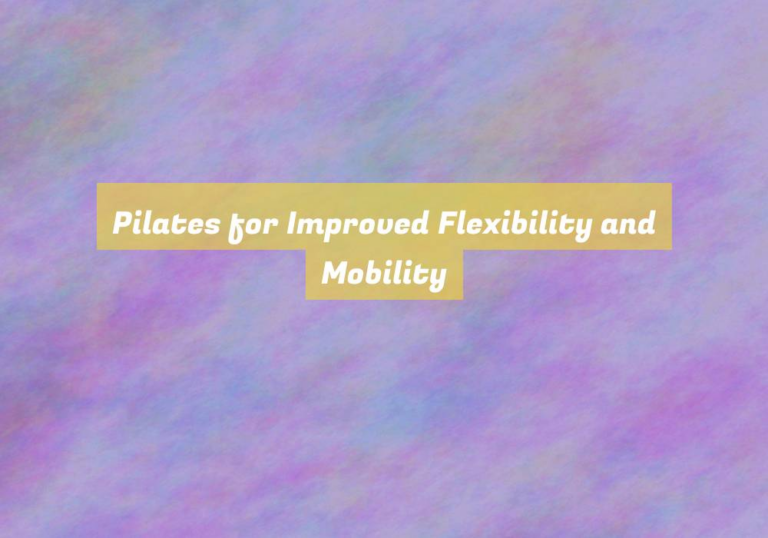Achieve Greater Flexibility and Mobility Goals
YouG??ve probably experienced the frustration of wanting to touch your toes without feeling like youG??re about to pull a muscle or struggling to move comfortably in certain yoga poses.
Achieving greater flexibility and mobility can seem like a daunting task, but with the right approach, itG??s entirely possible to make significant progress. By understanding the principles of flexibility and mobility, as well as incorporating effective techniques into your routine, you can unlock your bodyG??s potential for improved range of motion and overall physical freedom.
But where do you start, and how can you ensure that your efforts yield tangible results?
Understanding Flexibility and Mobility
To achieve your flexibility and mobility goals, understanding the importance of range of motion and joint flexibility is essential. Range of motion refers to the full movement potential of a joint, while joint flexibility is the ability of the muscles and tendons around the joint to allow for optimal movement. By comprehending these concepts, you can tailor your flexibility and mobility training to address specific needs and areas of improvement.
When you understand the significance of range of motion and joint flexibility, you can focus on exercises and stretches that target those areas. This knowledge empowers you to make informed decisions about the types of activities that will benefit you the most.
Additionally, understanding flexibility and mobility allows you to recognize the warning signs of limited range of motion and decreased joint flexibility, enabling you to take proactive measures to address these issues before they escalate.
Importance of Dynamic Stretching
Understanding the significance of range of motion and joint flexibility can lead to an appreciation of the crucial role that dynamic stretching plays in improving overall flexibility and mobility. Dynamic stretching involves moving parts of your body and gradually increasing reach, speed of movement, or both. It helps prepare your muscles and joints for the specific movements required during physical activity, making it an essential component of any flexibility and mobility routine.
By engaging in dynamic stretching, you promote better blood circulation and increase the temperature of your muscles, which can enhance their flexibility and range of motion. This type of stretching also activates the nervous system, improving muscle coordination and responsiveness. Additionally, dynamic stretching can help reduce the risk of injury during physical activities by preparing your body for the demands of the exercise.
Incorporating dynamic stretching into your daily routine can lead to noticeable improvements in your overall flexibility and mobility. ItG??s particularly beneficial before engaging in activities that require a wide range of motion, such as running, dancing, or playing sports. Dynamic stretching is a powerful tool in achieving your flexibility and mobility goals.
Incorporating Strength Training for Mobility
Consider integrating strength training exercises into your routine to enhance your mobility and flexibility. While many people associate strength training with building muscle mass, it also plays a crucial role in improving mobility.
When you engage in strength training, you not only strengthen your muscles but also increase the range of motion in your joints. By incorporating exercises such as squats, lunges, and deadlifts, you can target multiple muscle groups simultaneously, promoting better overall mobility.
Furthermore, strength training helps stabilize and support your joints, reducing the risk of injuries during physical activities. As you strengthen the muscles around your joints, you provide them with better support and protection. This can be particularly beneficial for individuals looking to improve their flexibility, as stronger muscles can aid in maintaining proper alignment and posture, leading to enhanced flexibility.
Incorporating strength training into your routine can complement your dynamic stretching efforts, resulting in improved mobility and flexibility. Aim to include strength training exercises at least two to three times per week to experience noticeable benefits in your overall mobility.
Recovery and Self-Care Techniques
Incorporating recovery and self-care techniques into your routine is essential for maintaining optimal flexibility and mobility.
After engaging in physical activities, itG??s crucial to prioritize recovery to prevent injuries and improve overall performance.
One effective self-care technique is foam rolling, which helps release muscle tightness and improve blood flow.
Additionally, practicing yoga or engaging in gentle stretching exercises can aid in maintaining flexibility and reducing muscle soreness.
Another important aspect of recovery is ensuring adequate rest and sleep, as this allows your body to repair and rebuild muscle tissue.
ItG??s also beneficial to incorporate relaxation techniques such as deep breathing exercises or meditation to reduce stress and improve overall well-being.
Furthermore, donG??t overlook the significance of proper hydration and nutrition in your recovery plan. Consuming adequate water and nutrient-rich foods supports muscle recovery and overall physical function.
Lastly, scheduling regular massages or using self-massage tools can help alleviate muscle tension and enhance flexibility.
Conclusion
Now that you understand the importance of flexibility and mobility, itG??s time to take action.
Incorporate dynamic stretching into your routine, add strength training exercises, and donG??t forget to prioritize recovery and self-care.
By doing so, youG??ll be on your way to achieving your flexibility and mobility goals.
Keep pushing yourself, stay consistent, and remember to listen to your body along the way.
YouG??ve got this!







